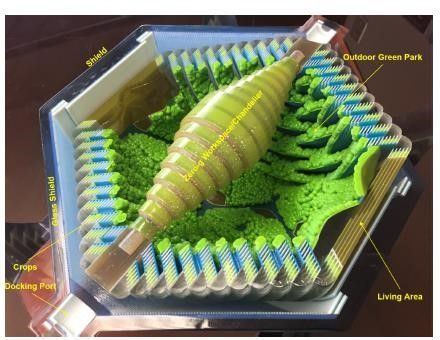#ArtificialGravity
Explore tagged Tumblr posts
Text
Could We Live on a Super-Earth? 2025
Could We Live on a Super-Earth? 2025 Super-Earths are among the most intriguing exoplanets discovered in recent years. These planets are larger than Earth but smaller than Neptune, and some might have conditions suitable for life. If we were to find a habitable Super-Earth, could humans actually live there? What challenges would we face, and what would life be like? Let’s explore the possibilities. What Is a Super-Earth? A Super-Earth is an exoplanet with a mass between 1.5 and 10 times that of Earth. Unlike gas giants such as Jupiter, these planets are likely to be rocky, potentially with water, atmospheres, and even weather systems. Some might be Earth-like, while others could have extreme conditions that challenge our survival. Scientists have already discovered hundreds of Super-Earths in our galaxy, and many exist within their star’s habitable zone—the region where liquid water could exist on the surface. However, being in the habitable zone doesn’t guarantee that a planet is actually habitable. Key Factors for Human Habitability For humans to live on a Super-Earth, several conditions must align. These include: 1. Gravity - Super-Earths have stronger gravity due to their larger mass. - A planet with twice Earth’s mass could have gravity around 1.2 to 1.5 times stronger, making movement more difficult. - Long-term exposure to high gravity could affect human muscles, bones, and circulation. If gravity is too intense, we might need exoskeletons or genetic modifications to survive. Launching spacecraft from such a planet would also be more challenging, requiring stronger rockets. 2. Atmosphere Composition - A Super-Earth must have an atmosphere with breathable oxygen levels. - If the air contains too much carbon dioxide or methane, it could be toxic. - A thicker atmosphere might provide better protection from radiation but could also increase surface pressure. Some Super-Earths might have extreme weather systems due to their dense atmospheres. Giant storms or high winds could make life difficult. 3. Surface Conditions - The planet should have solid ground for building shelters. - If it’s covered by a vast ocean, we would need floating or underwater cities. - Active volcanoes, earthquakes, or extreme temperatures could pose serious risks. 4. Magnetic Field Protection - Earth’s magnetic field protects us from harmful solar radiation. - If a Super-Earth lacks a strong magnetic field, its surface might be bombarded with cosmic rays, making life unsafe. - In such cases, we might need to live underground or build radiation-proof cities. 5. Climate & Temperature - If the planet is too hot, water will evaporate, creating a harsh, desert-like environment. - If it’s too cold, it could be covered in ice, limiting access to liquid water. - Tidal locking (where one side always faces the star) could create extreme temperature differences. For a planet to be truly habitable, it needs a stable climate, moderate temperatures, and liquid water on the surface.




How Could Humans Adapt to Life on a Super-Earth? If a Super-Earth meets the basic requirements for habitability, humans might be able to settle there. However, we would likely need to make significant adaptations: - Stronger Bodies: Over generations, humans might develop denser bones and more powerful muscles to handle stronger gravity. - Technology Assistance: Spacesuits, oxygen generators, and underground shelters could help us survive harsh environments. - Artificial Gravity Zones: If gravity is too strong, we might create low-gravity living spaces to reduce strain on our bodies. - Bioengineering: Future genetic modifications could make humans more resilient to extreme conditions. Challenges of Colonizing a Super-Earth Even if a Super-Earth is habitable, reaching it and surviving long-term would be extremely difficult. Some of the biggest challenges include: - Distance: Most known Super-Earths are light-years away. Current technology would take thousands of years to reach them. - Space Travel Limitations: We need faster spacecraft or generational starships to make the journey feasible. - Resource Scarcity: Transporting food, water, and essential supplies over such distances would be incredibly expensive. - Unknown Risks: Alien microbes, toxic elements in the environment, or unexpected climate patterns could threaten human survival. One possible solution is terraforming—modifying a planet’s atmosphere, temperature, and surface to make it more Earth-like. However, this process could take centuries or even millennia. Conclusion: Could We Live There? Living on a Super-Earth is theoretically possible, but it comes with significant challenges. If we find a Super-Earth with Earth-like conditions, humans might be able to settle there, but we would need advanced technology and major adaptations. Stronger gravity, different atmospheres, and potential environmental hazards could make life very different from what we know. For now, Super-Earths remain exciting candidates for future space exploration. With advancements in space travel, bioengineering, and planetary science, we might one day call one of these massive planets home. Read Our Past Blog: How Does AI Generate Human-Like Voices? 2025For more information, check this resource.
Could We Live on a Super-Earth? 2025 - Everything You Need to Know
Understanding could in DepthRelated Posts- Could We Live on a Super-Earth? 2025 - Could We Live on a Super-Earth? 2025 - Could We Live on a Super-Earth? 2025 - Could We Live on a Super-Earth? 2025 Read the full article
#1#1.19999999999999999983#1.49999999999999999978#10#2#2025-01-01t00:00:00.000+00:00#3#4#5#adaptation#artificialgravity#atmosphere#atmosphereofearth#atmosphericpressure#biologicalengineering#blog#bone#carbon#carbondioxide#climate#climatevariabilityandchange#cosmicray#earth#earthanalog#earthmass#earth'smagneticfield#earthquake#environmentalhazard#evaporation#exoplanet
1 note
·
View note
Text
Developing Space Habitats?
What space habitats are being developed by any of the space companies are government agencies for use on the Moon or Mars that implement spin gravity? I asked groq/mistral 8x to “Answer the questions with the intelligence of a NASA engineer, but in the format that a high school student can understand the answer.” Using Tara Prompter Advanced Node. There are many factors to consider when…
0 notes
Text

#plagiarismmagazine#plagiarismmagazineccseries#wasper#clandestineculture#waspershop#groundzeropopulationone#badinfluence#artificialgravity#plagiarismmagazinepmseries#gzpo
1 note
·
View note
Photo

What will happen to us in the absence of gravity? Can life persist without gravity? Can we create artificial gravity? Why have scientists been trying to design ‘spinning space stations’ for decades? If gravity is so important, then why are scientists across the globe researching on ‘zero gravity’? Space researchers are performing experiments to understand the physics, chemistry and biology of the ‘Microgravity’ environment and its effects on humans and other lifeforms, before sending them to Mars or somewhere else in space.
From treating multiple ailments to researching in a ‘Cubelab’, read the learning module to find how ‘no gravity’ is helping us prepare for space colonization…
https://acadru.com/learningmodule-brief/artificial-gravity-future-of-no-gravity
.
.
#artificialgravity#gravity#nogravity#sciencecommunicators#citizenscientists#astronauts#futurists#astrobiologists#astrophysicists#zerogravity#microgravity#artificialgravityroom#simulatedgravity#dryimmersionmethod#scienceinspace#spacepharma#psychoneurology#traumatology
0 notes
Photo

Forgot to post this pic of the other house that got a big mural. This is also awesome, it just gets blown out of the water by the other one I posted yesterday. Kari #art #partille #streetmeat #hitthebricks #graypower #ghey #waitandbleed #bloodyhell #hellbentforleather #northpole #sweden #sverige #gothenburg #notinthislifetime #artificialgravity #moveitbitch (at Partille) https://www.instagram.com/p/B0WVsOIoeAu/?igshid=xaoe4v753hl2
#art#partille#streetmeat#hitthebricks#graypower#ghey#waitandbleed#bloodyhell#hellbentforleather#northpole#sweden#sverige#gothenburg#notinthislifetime#artificialgravity#moveitbitch
0 notes
Photo

#Future #Space: design for a #SpaceHabitat with #ArtificialGravity that could be enlarged over time to fit more people 👁🗨 https://bit.ly/3i0BlHF via @UniverseToday https://bit.ly/340nigp
0 notes
Text
Deep Space Missions Must Recreate Exact Earth-Like Conditions to Survive, Scientists Argue
One of the main questions surrounding humanity’s next giant leap into deep space is whether humans can thrive on missions far from Earth. A new theory says yes, but only in environments modeled deeply after our own planet. Read more…

View On WordPress
#articles#artificialgravity#Environment#gravity#humanmissionstomars#humanspaceflight#leegirons#morganirons#outerspace#spacecolonization#spaceexploration#spaceflight#spacemedicine#spacexmarstransportationinfrastructure
0 notes
Text
Making Gravity?
Artificial Gravity in Space: ESSENTIAL Steps for Long-Term Habitation I asked Gemini 2.0: What is the difference between spin gravity, Hypergravity, and earth gravity? Gemini 2.0 Flash Experimental. Might not work as expected. Spin Gravity (Artificial Gravity): This is not true gravity but an artificial simulation of gravity created through rotation. It’s achieved by spinning an object or…

View On WordPress
#ArtificialGravity#astronomy#Gravity#NASA#SpaceExploration#@futuristictechnology1#artificial gravity#future#gravity#habitat#Hypergravity#physics#science#space#technology
0 notes
Text
#WASPERSHOP#wasper#plagiarismmagazineccseries#plagiarismmagazine#clandestineculture#groundzeropopulationone#artificialgravity#badinfluence#waspershop#gzpo#clandestineculturetshits#clandestineculturecollection#plagiarismmagazinepmseries#borninthestreets#cccbits
1 note
·
View note
Link
https://acadru.com/learningmodule-brief/artificial-gravity-future-of-no-gravity
#artificialgravity#gravity#nogravity#sciencecommunicators#citizenscientists#astronauts#elysium#spacescientists#futurists#astrobiologists#cubelab#astrophysicists#zerogravity#microgravity#ArtificialGravityRoom#ArtificialGravityChair#simulatedGravity#DryImmersionMethod#scienceinspace#spacepharma#psychoneurology#traumatology#orthopedics#ScienceInMicrogravity#AntiGravityWheel
0 notes
Text

#waspershop#wasper#plagiarismmagazine#clandestineculture#plagiarismmagazineccseries#groundzeropopulationone#badinfluence#borninthestreets#artificialgravity#artificialidentity#clandestineculturetshits
1 note
·
View note
Photo

Artificial Gravity, 2023. #artificialgravity #waspershop #wasper #plagiarismmagazine (at Hialeah, Florida) https://www.instagram.com/p/Cp7EblfuAzR/?igshid=NGJjMDIxMWI=
1 note
·
View note